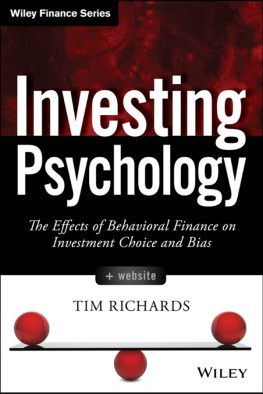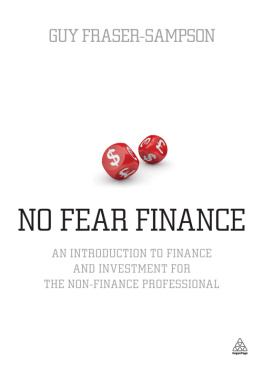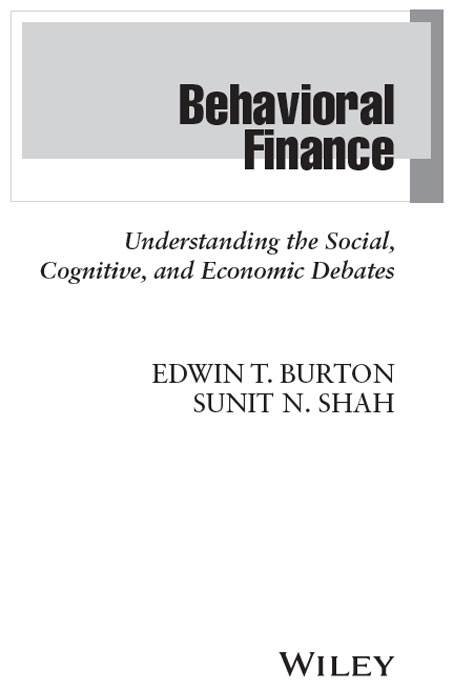Founded in 1807, John Wiley & Sons is the oldest independent publishing company in the United States. With offices in North America, Europe, Australia, and Asia, Wiley is globally committed to developing and marketing print and electronic products and services for our customers' professional and personal knowledge and understanding.
The Wiley Finance series contains books written specifically for finance and investment professionals as well as sophisticated individual investors and their financial advisors. Book topics range from portfolio management to e-commerce, risk management, financial engineering, valuation and financial instrument analysis, as well as much more.
For a list of available titles, visit our website at www.WileyFinance.com .
Cover image: Michael Leynaud/Getty Images
Cover design: Leiva-Sposato
Copyright 2013 by Edwin T. Burton and Sunit N. Shah. All rights reserved.
Published by John Wiley & Sons, Inc., Hoboken, New Jersey.
Published simultaneously in Canada.
No part of this publication may be reproduced, stored in a retrieval system, or transmitted in any form or by any means, electronic, mechanical, photocopying, recording, scanning, or otherwise, except as permitted under Section 107 or 108 of the 1976 United States Copyright Act, without either the prior written permission of the Publisher, or authorization through payment of the appropriate per-copy fee to the Copyright Clearance Center, Inc., 222 Rosewood Drive, Danvers, MA 01923, (978) 750-8400, fax (978) 646-8600, or on the Web at www.copyright.com . Requests to the Publisher for permission should be addressed to the Permissions Department, John Wiley & Sons, Inc., 111 River Street, Hoboken, NJ 07030, (201) 748-6011, fax (201) 748-6008, or online at http://www.wiley.com/go/permissions .
Limit of Liability/Disclaimer of Warranty: While the publisher and author have used their best efforts in preparing this book, they make no representations or warranties with respect to the accuracy or completeness of the contents of this book and specifically disclaim any implied warranties of merchantability or fitness for a particular purpose. No warranty may be created or extended by sales representatives or written sales materials. The advice and strategies contained herein may not be suitable for your situation. You should consult with a professional where appropriate. Neither the publisher nor author shall be liable for any loss of profit or any other commercial damages, including but not limited to special, incidental, consequential, or other damages.
For general information on our other products and services or for technical support, please contact our Customer Care Department within the United States at (800) 762-2974, outside the United States at (317) 572-3993 or fax (317) 572-4002.
Wiley publishes in a variety of print and electronic formats and by print-on-demand. Some material included with standard print versions of this book may not be included in e-books or in print-on-demand. If this book refers to media such as a CD or DVD that is not included in the version you purchased, you may download this material at http://booksupport.wiley.com . For more information about Wiley products, visit www.wiley.com .
Library of Congress Cataloging-in-Publication Data:
Burton, Edwin T.
Behavioral finance : understanding the social, cognitive, and economic debates / Edwin T. Burton and Sunit N. Shah.
pages cm.(Wiley finance series)
Includes index.
ISBN 978-1-118-30019-0 (cloth); ISBN 978-1-118-33410-2 (ebk);
ISBN 978-1-118-33521-5 (ebk); ISBN 978-1-118-33192-7 (ebk)
1. InvestmentsPsychological aspects. 2. Capital marketPsychological aspects. 3. Decision making. I. Title.
HG4521.B837 2013
332.019dc23
2012041904
Preface
This book was the product of five years of teaching Behavioral Finance to over 1,800 undergraduates at the University of Virginia. The course never had a textbook. In fact, the course was originally intended to be limited to, at most, 15 students due to the difficulty of the reading. By a strange quirk of the registration process, the course limit in the online registration system was altered to 300 and was quickly filled by eager students. It remains one of the most sought after courses at the University of Virginia. Who would have guessed?
When I first decided to offer Behavioral Finance as a course, I was driven by the amount of space that the subject was occupying in the leading finance journals. There was no book that I could find suitable for such a course, so the initial reading list was comprised solely of original sourcesprofessional, academic journal articles. Somehow, this worked, and students continue to pack into this course that is offered every spring at the University of Virginia.
It dawned on me that if this course proved useful to our students, perhaps I should write a book summarizing my thoughts on Behavioral Finance in book form so that others might consider offering a similar course at their institution. In this spirit, I dedicate this book to all of my studentspast, present, and future.
I would especially like to thank my co-author, Sunit Shah, whose brilliance and attention to detail has hopefully made up for much of my unintended carelessness. I would also like to thank my students Francesca Archila, Mu Chen, Qichen Wang, Grace Chuang, Samantha Rivard, and Patrick Glading for help with this book. I would also especially like to thank my daughter Lindsay Burton Sheehan for her help with numerous aspects of the final version. My wife, Trish, and my daughter Elizabeth Burton have been a constant source of encouragement toward the completion of this enterprise. Finally, I am grateful to Wiley for their patience and support in getting this book to print.
Edwin T. Burton
My fascination with financial markets was born with the execution of my first trade at age 17. From that point forward, through forecasting macro trends, to conducting actuarial analysis on life settlements, to creating predictive models around movements of credit spreads, that interest has evolved into an ever-present curiosity as to how one might beat the market. Its juxtaposition against my academic training at the University of Virginia, presented mainly through the lens of the Efficient Markets Hypothesis, provided the contrast between the two sides of the Behavioral Finance debate. As such, this book has served as the perfect transition in my life in finance, from academic setting to practice, from theory to application, from avocation to full-time vocation.
To Ed's sentiments, I'd simply like to add my heartfelt appreciation: to Ed for the opportunity to join him on this endeavor, and for setting the structure and organization to the topic that allowed our ideas to flow; to all of the aforementioned students for all of their assistance in this book's creation; and to all of my friends and family, including my parents, Nitin and Suhasini Shah, my sister, Vaishali Shah, and my niece, Kirsi Shah Chinn, for their continued support along this journey, and throughout my life in general.
Sunit N. Shah
Introduction
Behavioral finance is a subtopic of the broader subject of behavioral economics. The behavioral in the name means that the behavior of participants in the actual economy is fundamentally different than what most academic theorizing normally assumes. Behavioralists argue that the predictions of economics, finance in particular, must be modified to account for how people actually behave in economic situations.







![Daniel Crosby [Daniel Crosby] - The Laws of Wealth: Psychology and the secret to investing success](/uploads/posts/book/124058/thumbs/daniel-crosby-daniel-crosby-the-laws-of-wealth.jpg)

